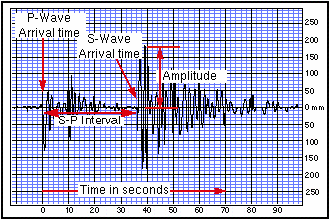What's an earthquake?Earthquakes occur because of a sudden release of stored energy. This energy has built up over long periods of time as a result of tectonic forces within the earth. Most earthquakes take place along faults in the upper 25 miles of the earth's surface when one side rapidly moves relative to the other side of the fault. This sudden motion causes shock waves (seismic waves) to radiate from their point of origin called the focus and travel through the earth. It is these seismic waves that can produce ground motion which people call an earthquake. Each year there are thousands of earthquakes that can be felt by people and over one million that are strong enough to be recorded by instruments. Strong seismic waves can cause great local damage and they can travel large distances. But even weaker seismic waves can travel far and can be detected by sensitive scientific instruments called seismographs.What are earthquake (Seismic) Waves?A seismic wave is simply a means of transferring energy from one spot to another within the earth. Although seismologists recognize different types of waves, we are interested in only two types: P (primary) waves, which are similar to sound waves, and S (secondary) waves, which are a kind of shear wave. Within the earth, P waves can travel through solids and liquids, whereas S waves can only travel through solids.The speed of an earthquake wave is not constant but varies with many factors. Speed changes mostly with depth and rock type. P waves travel between 6 and 13 km/sec. S waves are slower and travel between 3.5 and 7.5 km/sec. What's a Seismogram?
Note well: This seismogram is a simulation. The actual records
of earthquake waves are far more complicated than what is presented
here. As P and S waves travel through the earth, they are reflected
by various layers of the earth (such as the core- mantle boundary).
This interaction produces additional seismic waves (phases) which will
be detected by seismographs. Once you successfully complete this tutorial,
you will be given links to some seismology labs, where you can see real
seismograms.
How is an Earthquake's Epicenter Located?In order to locate the epicenter of an earthquake you will need to examine its seismograms as recorded by three different seismic stations. On each of these seismograms you will have to measure the S - P time interval (in seconds). (In the figure above, the S - P interval is about 45 seconds. The vertical lines are placed at 2 second intervals.) The S - P time interval will then be used to determine the distance the waves have traveled from the origin to that station. The actual location of the earthquake's epicenter will be on the perimeter of a circle drawn around the recording station. The radius of this circle is the epicentral distance. One S - P measurement will produce one epicentral distance: the direction from which the waves came is unknown. Three stations are needed in order to "triangulate" the location.
Copyright © 1996-2019 Virtual Courseware Project
|


